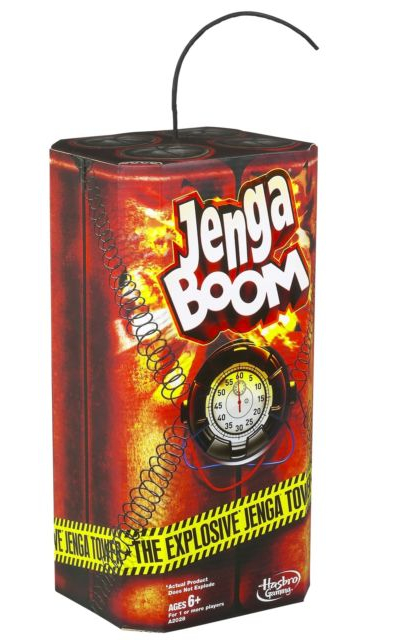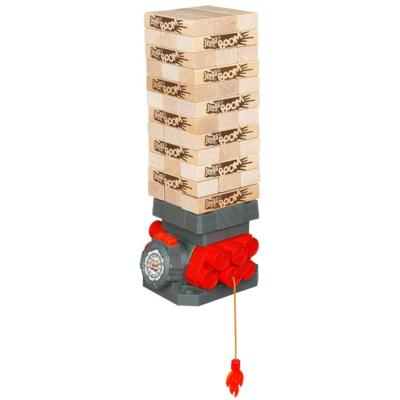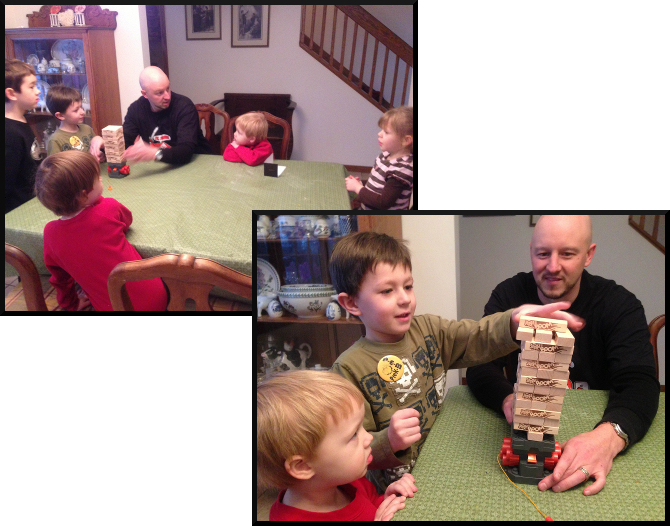
The Basics:
- For ages 3 and up (publisher suggests 6+)
- For 1 or more players
- Variable time to complete
Geek Skills:
- Logical & Critical Decision Making
- Hand/Eye Coordination & Dexterity
- Pattern Matching
- Reflex & Speed
Learning Curve:
- Child – Easy
- Adult – Easy
Theme & Narrative:
- None
Endorsements:
- Gamer Geek rejected!
- Parent Geek approved!
- Child Geek approved!
Overview
Pop quiz, hot-shot! You’ve got less than a minute to carefully move a block from a stack and then balance it on a wobbly tower. What’s the only thought that should be in your head? HA! Trick question, rookie! That answer is “nothing”! This is a game where you only have time to do two things: be quick and precise! Leave your brain at the door, check your gut, and bring your moxie!
Jenga BOOM, by Hasbro, is comprised of 36 wooden rectangle blocks and one plastic “Bomb” platform. The platform has a pullstring at its base, an “on/off” switch, and a plastic tab that locks the platform in a raised position. A cardboard stacking sleeve which doubles up as the game’s instructions is also included. The game easily fits in the box it comes in when not in use.
Three fun artistic points-of-interest that should be noted. First, the game box is in the shape of a bundle of dynamite with a detonation timer wrapped around it and a fuse sticking out at the top. This is a strong hint to the casual observer of the game’s explosive nature. Second, the plastic “Bomb” platform looks like a bungle of dynamite that is supporting the tower. The pullstring is the fuse that is going to ignite the dynamite, but there is also a detonation timer connected to the bundle. The individual who set the explosives really wants it to explode, apparently. Also, and for reasons I cannot explain, the bundle of dynamite has tank treads on both sides. READY TO ROLL! Third, and finally, the manufactures were compelled to inform the consumer with a small note at the bottom of the box that states the “Actual product does not explode”. This makes me sad because it suggests there were people in Hasbro’s test marketing group who were either disappointed that it didn’t or really thought that Hasbro was selling explosive incendiary devices to families and were rather put out by it.

Game Set Up
To set up the game, first and foremost, find a flat and very stable surface that all the players can crowd around.
Second, place the plastic “Bomb” platform in the middle of the playing area and set the “on/off” switch to the “off” position. Then pull the string at the platforms base all the way about.
Third, using the tab on the side of the plastic “Bomb” platform, lock the platform in its highest position.
Fourth, build the Jenga tower on the raised platform using the wooden blocks. Each row is comprised of 3 blocks and each row should alternate in block placement direction.
That’s it for game set up. Decide the play order and begin!
Working Under Pressure
The game is played with each player taking a turn. Once their turn is over, the next player goes and so on. On a player’s turn, they will complete the following steps in sequential order.
Step 1: Start the Timer
At the base of the plastic “Bomb” platform is the “on/off” switch. When there are no players taking a turn, it is set to the “off” position. The first thing a player will do is firmly and carefully set the switch to the “on” position by pressing down on it. The pullstring will start to retract back into the base of the plastic “Bomb” platform simulating a burning fuse and a ticking sounds will emit from the game’s base.
Step 2: Remove and Place Block
As quickly and as carefully as possible, the player now uses one hand to remove any single block below the highest row. Once removed, the block is placed on the top of the tower either to an existing row or starting a new row. The rows should always be built in alternating directions and no more than 3 blocks wide. The player can start a new row by placing a block in the left, right, or middle position on top of the tower, but a new row can only be built on a completed row of 3 blocks.
Step 3: End of Turn
Once the block is placed, the player sets the timer back to its “off” position. This ends the player’s turn and the next player now goes starting with step 1 above.
And BOOM Goes the Dynamite
The game will end one of two ways.
The first and most likely way is the tower crashing down because it is off-balance. If this happens during a player’s turn and before the next player starts their turn with step 1, that player has lost the game.
The second and much more dramatic ending is the tower crashing because the plastic “Bomb” platform timer has run out. When this happens, the supporting base literally falls out from underneath the tower. If this happens during a player’s turn and before the next player starts their turn with step 1, that player has lost the game. The timer on the plastic “Bomb” platform runs roughly 60 to 63 seconds before it drops the platform.
Given the two end conditions, and if there are 2 or more players, everyone else in the game wins except the person who knocked the tower down or the tower was exploded before the next player could take their turn. Either way, hilarity and grumpy faces will ensue.
And if you aren’t familiar with the “boom goes the dynamite” phrase, consider yourself educated.
House Rules
To help the game along and when playing with young Child Geeks, we had one adult hold the base and be in charge of starting and stopping the timer. This allowed the Child Geeks to focus on building the tower and reduces the possibility of the tower being accidentally bumped. The “on/off” switch can be a bit tricky for little fingers to press. As a result, the timer could run longer than it should or the tower could be tipped because the Child Geek is putting too much pressure on it.
Alternatively, and instead of each player turning the timer on and off during their turn, the players can just take their turns as quickly as possible as soon as the timer starts. The game is played as described above, but the timer remains “on” for the duration of the game. Same win and lose game conditions apply. This House Rule also allows for solitaire play.
Of course, if playing with new players, the plastic “Bomb” platform can be removed from the game entirely. This allows for “normal” Jenga game play and is a great way to introduce the game to new players without adding the additional stress of an explosive ending.
To learn more about Jenga BOOM, visit the game’s web page.
Prediction
Ah, Jenga, my old nemesis!
When the original Jenga was introduced 1983, it was all the rage. I remember wanting it so badly for Christmas and my parents wondering why on Earth they should spend good money on a pile of small wooden blocks. Didn’t I already have LEGOs to play with, they doubtless thought? Didn’t matter, of course. A child around Christmas time can be exceedingly persuasive and annoying. I either broke them down and they relented or they thought it was a good idea, too. Regardless, it was found on Christmas morn wrapped in festive paper under the family Christmas tree. I’ve been in a love/hate relationship with the game ever since. Be careful what you wish for, kids.
Since its initial release, Jenga has gone through what I call the Monopoly Effect. This is when a game gets rethemed again and again and again using its basic game mechanism principles wrapped in a new packaging to entice would-be shoppers. A quick look at Board Game Geek reveals that there are no less than 30 different versions of Jenga. There were 5 new versions of the game released in 2012 alone, one of which we have already reviewed. That’s pretty absurd for a game that is basically just blocks and there will doubtlessly be more released in the future. I’m holding out for a Knight Rider themed Jenga game!
But one cannot argue that the game has long-lasting appeal and is easy to play. It’s very simple: take a block and stack it. We’ve been doing that since we were living in caves and stacking rocks. Heck, we learn this skill when we are babies and playing with our blocks on the floor or in the crib. What Jenga is doing and has been doing is not new. It’s in our blood and in our genes. Jenga just made it a game. That’s why I have no doubt that Jenga BOOM is going to be easy to teach, but only the Child and Parent Geeks are going to approve it.
Jenga has always been a fun family and party game. The addition of a timer that makes everything more chaotic is just going to add to a groups excitement, and possibly, frustration. For the Gamer Geeks, the explosive platform is not going to be seen as a challenge, but an unnecessary element of difficulty. For a serious Jenga player (if such people even truly exist), the game is about taking your time and collectively building a tower to the sky. At first, the game is about the individual, but as it rolls on, everyone starts looking at the game as a cooperative challenge. When the tower gets knocked over, everyone is disappointed. With the timer forcing the tower to explode, that type of game play is removed.
And so, I introduced the game to family and friends. The majority thought the new box and game play was an interesting twist. The Gamer Geeks didn’t think it was innovative, but they agreed it was an interesting idea, albeit unnecessary. Teaching the game is simple, of course, but I gave all the youngest Child Geeks test runs so they could get the feel of the tower’s balance and how the blocks moved. This was especially important for my 3-year-old who asked so sweetly if he could play, too. I made sure he understood how the game was played and how important it was to be careful with the tower. I then made him demonstrate block removal and placement several times. Once the older Child Geeks felt confident that the youngest among them wasn’t going to simply knock the tower over, they were happy to include the 3-year-old. After that, it was just a matter of setting the timer, building the tower, and standing back. But before I let them go at it, I asked my Child Geeks what they thought of Jenga BOOM so far.
“Neat! It’s super cool that the tower explodes!” ~ Liam (age 8)
“This is so cool, Daddy! Will the tower go all over the room?” ~ Nyhus (age 5)
“I can play, Daddy! I can? Yeaaaaaaah!” ~ Ronan (age 3)
Once the Child Geeks stopped jumping up and down excitedly (knocking the tower over twice), we started the game. Let’s see if Jenga BOOM is an explosively good time or a dud.
Final Word
As predicted, Jenga BOOM was a huge hit with the Child Geeks, but not for long. The excitement of the explosive base started to wear off after a few games and they decided to simply start building structures on top of it to watch them explode instead of playing the game. When I asked if they preferred the Jenga game with or without the explosive base, they said they liked the game better when it was included. What they didn’t like was how the timer would sometimes be difficult to start and stop. This caused some extreme frustration for the younger Child Geeks who couldn’t press down on the “on/off” switch hard enough to stop or start the timer. As a result, an older Child Geek or a Parent Geek was always stationed nearby to provide timer assistance if need be. Despite the unfortunate sticky timer, all the Child Geeks voted to approve it. As an extra bonus, my 3-year-old did great! If you have a younger Child Geek, do give this game or another version of Jenga a try with them. Ignore the manufacturer’s age suggestion. Your Child Geek knows all about stacking blocks and can probably teach you a thing or two.

Just a typical day after school at our house… snacks, friends, and games…lots of games…
Parent Geeks thought the new concept of a timed Jenga game was a good one, but they were rather sad they couldn’t keep building a tower as a group. The timer made sure of that. They originally thought the starting and stopping action of the timer would cause problems for the players and compromise the tower’s stability, and it did, but they found ways to work around it. In the end, they didn’t think it was as big an issue as they originally thought and they liked the new “fast paced” feel the timer provided. They voted to approve the game for quick plays and fun times at the family gaming table.
The Gamer Geeks, as predicted, said “no thanks” to the new Jenga BOOM and thought the timer was an absolutely unnecessary addition. According to one Gamer Geek, “the challenge of Jenga has always been one of building a tower as high and as carefully as possible. Adding a timer and forcing the tower to be destroyed feels like they made the game dumb and cheap.” Not all the Gamer Geeks felt that strongly about it, but they collectively agreed that the timer wasn’t necessary. The game was challenging and entertaining enough and they felt the timer added an unwelcome element that rushed the game.
I do not care for this version and think it is flawed in several ways. First of all, the intent of the game is contradictory to the game play. Jenga has always been a game about balance and control, logical thinking and careful consideration of the game as a whole, not just the turn at hand. With the timer now in play that will knock the tower over, the sense of comradery that usually comes from the game play when the tower is getting obscenely tall is gone, as is much of the logical thinking. It is now a game reduced to speed and chaos. Second, the pullstring does nothing to suggest the time left on the timer. Sometimes it is pulled in and sometimes it is not. As a result, there is no reliable way to know how much time is left in the game or how much time a player has to ponder their predicament. You could argue that this just adds to the tension, which it does, but not in a fun way. A player never knows if they have time to think or if they should rush. This forces some players to move too quickly, and as a consequence, cheat themselves out of a victory.
But despite my feelings towards the new version of the game, I agree with the Parent and Child Geeks when it comes to the game’s level of excitement. It’s just not the kind of excitement I want in my Jenga game. I’m already frustrated enough with other players “not building the tower right” or my fat man-hands getting in the way of delicately pulling blocks. The timer removes all this, of course, and I just focus on getting the block out and on top of the tower as quickly as possible. It’s just another way to view and play the game, but it works. For those who are looking for a fast dexterity game that will challenge them to keep cool and focused, Jenga BOOM is sure to please.
This game was given to Father Geek as a review copy. Father Geek was not paid, bribed, wined, dined, or threatened in vain hopes of influencing this review. Such is the statuesque and legendary integrity of Father Geek.




Loved playing Jenga when I was a kid and the game transitioned well into my college years. I think that I’m going to give this new version some house rules: the timer can be reset after a successful tile removal and placement if the player so chooses. Hopefully, this will be able to motivate the more carefully slow players to speed up and keep the game relatively close to the original.
Once the players go around a few times, they’ll be very sensitive to the fact that the timer will end and the tower will topple at anytime. I guarantee that players who like to play slow and calculate their moves are going to find this stressful. 🙂